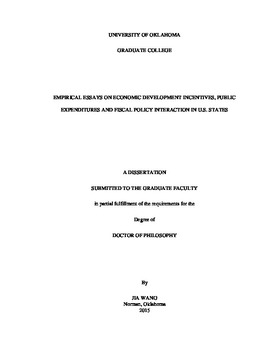| dc.description.abstract | Economic development incentives (EDI) have been widely used by state and local governments over the past three decades. They are viewed as an important tool to attract business investment, create jobs and ultimately stimulate economic growth. Despite extensive research on this topic, however, no consensus has been reached regarding the efficacy of such policies. This dissertation evaluates existing literature, explores a new database, and provides empirical contributions to research on EDI. Findings of this research are of direct interest to policymakers.
Chapter 1 surveys the empirical literature on EDI and discusses major EDI data sources. It summarizes EDI use at the state level based on the Subsidy Tracker database, which is subsequently used for the empirical research throughout the rest of this dissertation. Some highlights of the database include the following. Overall, there has been a proliferation of EDI use in all regions in the US, but states differ greatly in EDI utilization. Generally, the number of programs is a poor representation of states’ EDI efforts. Aggregately, the South Region outspends the rest of the US even though the Midwest Region offers the most programs. Among different types of EDI, tax credits/rebates dominate, followed by grants/low cost loans.
Chapter 2 investigates whether EDI spending crowds out public expenditures in U.S. states. The possible under-provision of public goods as a downside of incentive use has long been noted as a major concern in both academic and media outlets. Empirical evidence addressing this issue, however, has been scanty. Exploiting the Subsidy Tracker database, this chapter contributes to the existing literature in several ways. First, I use state-level panel data that allows for more generalizable analysis compared with case studies focusing on one program in a single geographic location. Second, this chapter investigates the effect of incentives on public goods provision at the state level instead of local level (county or city). Previous literature emphasizes that incentives may have different effects at the state level versus local level (Peters and Fisher, 2004), but empirical work primarily focuses on the local level. Third, the Generalized Method of Moments approach is employed to account for dynamic features associated with public expenditures. Potential endogeneity of policy variables and problems with unbalanced panels are also addressed. The specification uses lags of EDI values to accommodate possible delayed responses. Results show relatively little effect of EDI on most public goods expenditures in the first two time periods (including the current year) with negative repercussions beginning to appear in year two and provide some evidence of crowding out of productive public goods. Considering the important role productive public goods play in the state’s long term growth, my results should serve as a warning to policymakers who contemplate using EDI programs to stimulate the economy.
Chapter 3 employs spatial econometric techniques to estimate the extent of strategic interaction in states’ EDI spending decisions. Using a national search engine for EDI utilization, it is the first to examine strategic interaction in incentives use at the state level. It extends existing literature by exploiting panel data across states and by allowing for different definitions of neighbors to explore different EDI competition patterns across states. Results from 22 states during the period 2000 to 2011 indicate the presence of strategic interaction: states increase their EDI spending when their neighbors do so. The estimates range from 37 cents to 81 cents increases in EDI spending per dollar increase in neighbor’s EDI spending and are robust to numerous checks. Further, interstate competition in EDI spending does not seem to get more intense after the 2008 financial crisis, nor does it seem to be affected by state governor election cycles.
Chapter 4 provides a preliminary examination of the relationship between EDI spending and state level income inequality. Results from dynamic panel methods indicate that EDI use is positively associated with the income share of top percentile. This poses a caveat to policymakers as EDI use could be linked to widening income inequality which could offset other possible benefits associated with EDI programs. Extensions for future research are discussed at the end of the chapter. | en_US |
